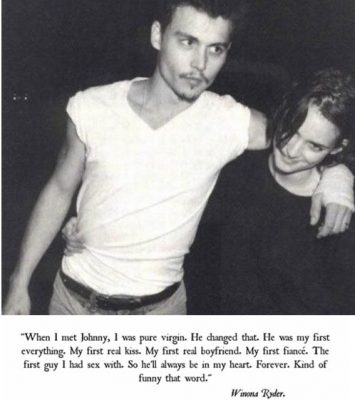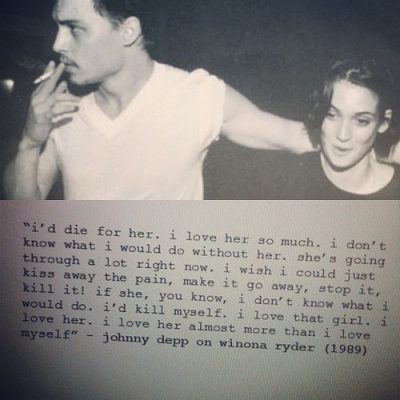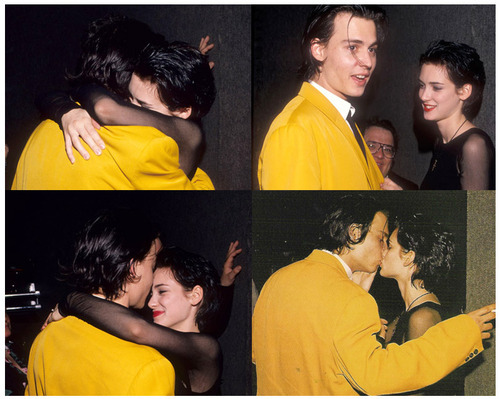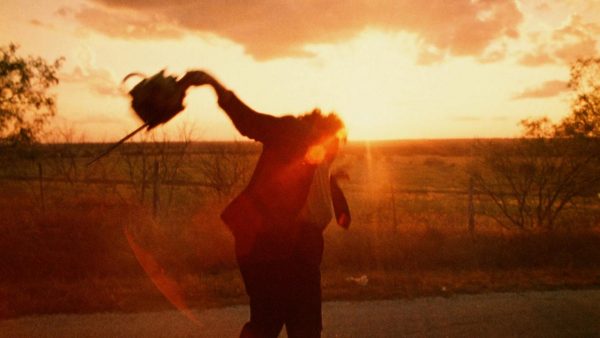‘However, somebody killed something: that’s clear, at any rate—’
Through The Looking Glass, Lewis Carroll
I. BEGINNING
I was a pre-teen when Winona Ryder and Johnny Depp moved into a loft across the street from me in Tribeca, where I lived. An older neighbour friend, the sister of a classmate, told me they were living in her loft building, on the top floor. I went home and looked for them that very same day. I saw him at my corner deli, and on the street smoking, but never her. At night, I sometimes looked up at their windows and saw their lights on. The older friend said they had no furniture and seemed nice. Depp was not very impressive in person. Cute, but no big deal. His jeans had paint on them and his t-shirt had holes. You might not look at him unless you knew you were supposed to, which is really the singular difference between people on-screen and people off-screen: famous people are to be looked at.
The story is Ryder didn’t want to live in pre-gentrification Tribeca because it was too isolated and scary to her, so they moved out after only a few months. This is of course ridiculous. Who could be afraid of Tribeca, already considerably gentrified by the early 90s, unless they were supremely bougie? Ryder was supposed to be this bohemian girl; this down-to-earth hippie, who could live anywhere and had grown up on a California commune. But it turned out that the Lower West Side of Manhattan in the early 90s, primarily still a white artist’s enclave at that point, was just too wild for her.
I loved Winona Ryder then. I, a weird-girl, could not believe that a weird-girl like her was on screen when she showed up in Beetlejuice and Heathers. Her creaky voice, black eyes, and 1940s style dark hair, which she chose over her allegedly natural blonde. I even forgave Ryder her bad acting in period films like The Age of Innocence, Dracula, and The House of The Spirits because of how much her counter-image meant to me. Her look, her clothes, her early movies. Her boyish, impish, scruffy taxi driver in Jim Jarmusch’s Night on Earth, before I even knew who Gena Rowlands was.
II. MIDDLE
Some actors are only made to play certain parts, revealing something about an age through their own age. Personal chronology becomes cultural chronology, and vice versa. Like John Cusack, another black haired/pale skinned 80s/90s idol, as well as a youth actor whose great, and perhaps only gift, was to enact a different kind of youth (a counter-youth and counter-masculinity) in his youth, Winona Ryder was never timeless, she was of the time. Most especially that brief time in her life, her teenage years and early twenties. Perhaps this is why Jake Gyllenhaal’s light hair was dyed jet-black for the retroactive Donnie Darko, and Christian Slater’s jet-black for Heathers. Something about dark hair showing up in the late 80s and early 90s as a form of retribution for an aesthetically fascistic and representationally narrow decade. These are people who were not kissed by the sun, who were not California Dreamin’, or, as the German writer Heinrich Laube puts it, ‘These pale youths are uncanny, concocting God knows what mischief.’
If, as the teenage radio pirate DJ, ‘Hard Harry’ puts it in Pump Up The Volume (1990), the 80s were a totally ‘exhausted decade, where there’s nothing to look forward to and no one to look up to’, Winona Ryder rose up from the bleached-blonde ashes of the 1980s. Playing the 90s was Ryder’s part, for once they ended, her specificity did not carry over. She was characteristic, not character(s). Nor did she ever manage to recoup her cultural relevance, whose finish culminated dramatically with an arrest and public trial for shoplifting in 2001. And how could she when we no longer cared about the same things and when she didn’t either? Given that culture speaks through bodies, faces, and colors, as well as events, Ryder is a temporal archive rather than an Actor; a famous tomb, which all actors are in varying degrees. Ryder was employed not to play a range of characters well—the way actors are traditionally expected to, and the way we knew Ryder wasn’t especially good at doing—but to reflect something about a particular time and mood. According to the filmmaker Robert Bresson, who referred to actors as models, and who mostly hired non-professionals, this is the actor’s true role. ‘To create is not to deform or invent persons and things,’ Bresson writes in Notes on the Cinematographer, ‘it is to tie new relationships between persons and things which are, and as they are.’
III. END
In 1989, Winona Ryder and Johnny Depp, a couple, both made public declarations about each other in the press:
Winona Ryder: ‘When I met Johnny, I was pure virgin. He changed that. He was my first everything. My first real kiss. My first real boyfriend. My first fiancé. The first guy I had sex with. So he’ll always be in my heart. Forever. Kind of funny that word.’
Johnny Depp: ‘I’d die for her. I love her so much. I don’t know what I would do without her. She’s going through a lot right now. I wish I could just kiss away the pain, make it go away, stop it, kill it! If she, you know, I don’t know what I would do. I’d kill myself. I love that girl. I love her. I love her almost more than I love myself.’
A couple of years later, Ryder and Depp broke up. Even though it didn’t last, and they didn’t die (or who knows, maybe they did. Ryder certainly died in some ways, and Depp did too, in his ways), here they are, two Hollywood stars at the top of their game, saying this about each other in print. Talking about dying when, according to Hollywood, which considers itself reason enough to live, these two have everything—not just each other—to live for. Today public relations would nuke a statement like this. Today no one ever takes old words lost to lost worlds like ‘die’ and ‘forever’ seriously. Nor would anyone even think to publicly state this about someone else, someone they love, let alone an actor in print. Today public relations would tell—or worse, would no longer have to—Ryder and Depp not to talk like that in public because talking like that is morose and alienates fans, especially when the lovers in question are young, famous sex symbols. Can we imagine two actors saying this today, killing their burgeoning careers with melodramatic words like forever and die, when most celebrity couples won’t even discuss their love lives, let alone admit to dying over a breakup? For a while, Gwyneth Paltrow, once good friends with Ryder, talked about her first big love, Brad Pitt, this way. But after they broke up, and she became a seasoned actor both on and off the screen, Paltrow, like Depp and Ryder, stopped talking like that, stopped talking about love period, which means that maybe a part of Paltrow stopped being able to feel that way. After all, how one talks is also how one lives.
By the end of Depp’s public declaration of love for Ryder, however, the promise of forever is shattered. Depp admits that he loves Ryder ‘almost more’ than he loves himself. The admission is a red flag, a glitch in the love story, despite his ‘Winona Forever’ tattoo, which he later edited to ‘Wino Forever’. On the surface—the famous tattoo—Depp is literally able to drop his object of desire and replace it with something else, in this case, addiction. This is hardly surprising given the preemptive mourning Depp does in his account of Ryder, anticipating and engraving loss into his relationship at the very pinnacle of their love. If, as Freud argues in Mourning and Melancholia, melancholy is mourning in advance, the tattoo amendment itself is an affect of grief. Melancholy foreshadows mourning. As Avital Ronell and Jacques Derrida have shown us, inscription and encryption, addiction and dependency, are close relatives and stand-ins for one another. Even before Depp actually lost Winona he was expecting to lose her. Maybe even trying to. In the case of Depp’s tattoo, forever endures as the only constant. It is what comes before and after forever that changes, and it is the addict who gets away with breaking his word. In ‘Wino Forever’, inscription and encryption are updated and reframed more broadly as addiction forever. In Crack Wars, Ronell writes that ‘drugs resist conceptual arrest…Precisely because they are everywhere and can be made to do, or undo, or promise, anything. They participate in the analysis of the broken word.’ In order to break the promise of love—of forever—the addict steps in as the figure of unreliability. Just as melancholy is mourning in advance, the addict is the person you were never meant to depend on or trust; whose promise is broken in advance.
While Depp had to remove traces of his old love object in order to make room for new ones that would undoubtedly disapprove of the tattooed remnant, the Winona/Wino alteration chronicles the continuous loop of mourning and melancholia. Of course Depp chose the word Wino precisely because of its playful, lexical proximity to Winona. By dropping the last two letters from her name, Wino was conveniently piecemealed. And yet, despite the fitting phonetic shorthand, he could have erased the tattoo completely, replacing it with an altogether new engraving. Instead, Depp enacts only a partial (token) erasure, so that something that did not last forever could nevertheless forever remain as a record of what has been lost. It the dialectic between what is preserved and what has been (unsuccessfully) rubbed out that is crucial here. What the corrective Wino masks, or pretends to, is the exteriority of mourning. ‘The stomach became the tomb,’ Avital Ronell writes in Crack Wars. ‘At one point Baudelaire seems to ask: whom are you preserving in alcohol? This logic called for a resurrectionist memory, the supreme lucidity of intoxication, which arises when you have something in you that must be encrypted.’ Wino is a hyper-cathection, which screams, rather than silences, ‘Winona was here!’ Wino wallows—swims—in what is left of Winona. A cheeky ode to alcoholism, Wino is Depp’s recovery from Winona. It is Winona, not alcohol that is the drug. One addiction simply serves as a decoy for another. Rather than erasing her, Wino pushes Winona deeper inside (Derrida: ‘the cinder is not what is. It remains from what is not’). Is love simply a manic episode for the melancholic; something that always ends in disaster, the way it does for Justine in Lars Von Trier’s Melancholia? The melancholic always expects—sees—what’s coming. In the film, Justine’s wedding day anticipates not only the end of her short-lived marriage, which lasts all but one day, but also the end of the world. In Von Trier’s apocalyptic narrative, there is no longer a point to living. Justine is the embodiment of that finality. Her melancholia, now an all-pervasive state in the twenty-first century, foresees not only the end of the world, but the end of the world is a planet called—cathected as—Melancholia. A planet (condition) that literally and figuratively crashes into Earth (everyone), the way it crashes into Justine, obliterating everything (Armageddon). Freud writes that mania, a converse state of melancholia, and which melancholia tends to change into, shares its content with melancholia. Addiction, a substitute for the love-relation, as Ronell points out, is often one of the forms that mania takes. Mania brings out the dead, the buried, the repressed, by keeping it there. By giving it a tomb.
Freud:
In melancholia, accordingly, countless are carried on over the object, in which hate and love contend with each other; the one seeks to detach the libido from the object, the other the other to maintain this position of the libido against the assault. The location of these separate struggles cannot be assigned to any system but the unconscious the region of the memory-traces of things (as contrasted with word-cathexes).
Both the body and words, which are co-intricated in Depp and Ryder’s oral love letters, require editing and rephrasing when things—’Winona Forever‘—don’t go as planned and death does not part. In both the press quotes and Depp’s tattoo, words—forever, first, virgin—literally get played out on the body. An inscription appears. An inscription is erased, rewritten, and turned into encryption. What disappears from view (Winona) goes into a vault under the skin. Equally, words go with the body, go where the body goes, goes on with and without other bodies: taking the body out of the world and sinking deeper into the world of the body. Words stitch bodies and lives together; bind them and break binds. The answer to what Depp would do without Winona is provided by the tattoo amendment. Depp finds a way to live with melancholy and the consequent symptoms of mania—addiction (Wino)— not Winona (mourning)—forever, for while mourning is unsustainable (it tells us what we are missing in no uncertain terms), melancholy is (it allows us to live with what we are missing because we don’t know what we’re missing).
Before Johnny, Winona tells us, she was ‘pure virgin’—unmarked, unsigned, no intrusion had been made. A self-proclaimed clean slate, ‘nothing,’ she says, was in her yet. But there is a masculine-feminine polarity to Depp and Ryder’s amorous declarations. For one thing, Winona’s testimony of love is more buoyant than Depp’s. It has a levity that Depp’s melancholy and weighted declaration doesn’t. Yes, Ryder is younger and self-admittedly inexperienced. And yes, she is a woman—a girl then—so her forever is feminized, and thus expected to take a more innocent and receptive form. She thinks forever is ‘kind of a funny’ word because it is her ‘first’ forever. The hierarchical construction to Depp and Ryder’s relation is almost Pygmalion here: he fills her with experience (first kiss, first sexual partner, first marriage engagement—’first everything.’ ‘The living likeness of my ivory girl,’ Ovid). He is teacher and she is student. But how does a woman, even a modern woman like Ryder, gain experience without being ruined? How does an actor of one age survive the failure to endure in another? In the 1938 film, Pygmalion, based on George Bernard Shaw’s play of the same title, Eliza Doolittle’s repeated insistence, ‘I’m a good girl, I am’ echoes Ryder’s archetypally nineteenth century appeal to sexual and empirical innocence. The 90s can be considered Ryder’s age of innocence (a movie she starred in 1993), for after her arrest and public trial a decade later, Ryder, the virgin, became Ryder, the fallen woman. Like Emma Bovary, no experience turned into too much experience.
ADDENDUM
Unlike Winona’s seemingly death-free testimony of love, which focuses on Depp’s role in bringing her to life, death figures prominently in Depp’s hyperbolic pronouncement of love: dying for, dying with, dying because of, dying for the one who dies—who wants to, as Depp suggests Ryder sometimes wanted to—which causes the lover to die with/for the beloved. As the end of endings—endings as Events and absolutes—could be said to define the 1990s, death contains the life of these two 90s lovers and holds it in precarious balance. Life tips the scale of death, and vice versa. Life depends on someone else, and when people are very young, they are still willing to admit to this. Adulthood requires one to learn to live without, to get used to and good at splitting up, moving on, whereas childhood is marked by profound dependency. The permissible dependency of childhood gets shaken off and uprooted—not driven deeper—by trauma and a lifetime of loss. So that what one discovers as one gets older is that being able to live without people is the requirement of life: living without the people you said you did not, would not, and could not live without; and, living without the people who said they could not live without you.
Life goes on in spite of death, in spite of lost objects and lost worlds, the things (relationships) that die, in spite of our pledges to die for the death of our Others, and in spite of wanting to prove our in-ability to live. Worst of all, we learn to live without even wanting to prove that we would stop living with-out someone. Belief in this world and belief in someone break up like lovers. And as time goes on, we live without admitting to the possibility that dying is even on the table. In the end, this isn’t a nineteenth century novel, it is late twentieth century Hollywood, and Depp is—or was—a modern bad-boy and an expensive commodity who, at least professionally, outlived Ryder (he has the tattoo to prove it), and that means some people can’t afford to die. They can only pretend to. Can only adjust their idea of what and who is worth living for.






